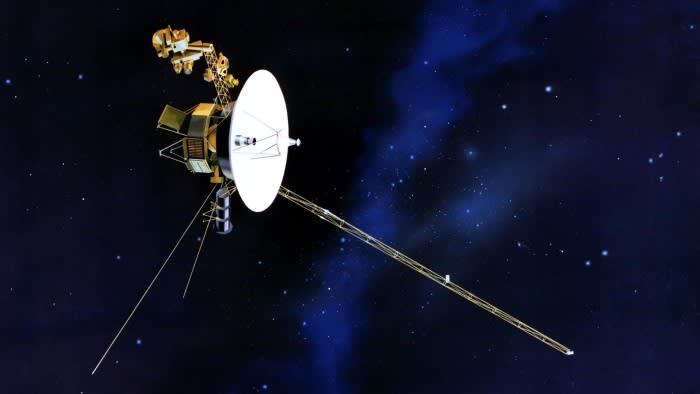Unlock the Editor’s Digest for free
Roula Khalaf, Editor of the FT, selects her favourite stories in this weekly newsletter.
The writer is a science commentator
A ghost has come back to life. Voyager 1, a spacecraft dispatched in the 1970s that had been sending signals back to Earth continuously until it malfunctioned in November, has been revived. Nasa engineers revealed last week that, thanks to some clever workarounds, they had remotely fixed the corrupted memory in one of its three onboard computers.
Gone is the melancholic string of ones and zeroes that signalled little beyond a pulse. Voyager 1, now outside the solar system and the most distant man-made object at 24bn km away, has begun sending meaningful signals once again.
The news feels both uplifting and bittersweet. Uplifting, because it embodies a golden age of space exploration that kicked off in the 1950s, put men on the moon, and gave us the first true glimpse of our planetary neighbourhood. Bittersweet, because this craft feels like a relic from a different era — one in which horizons were literally expanding, ambition and optimism were abundant, and technology seemed built to last.
The twin Voyager mission was launched in my childhood and, ever since, it has been hard not to romanticise it as a fellow traveller: sent off alone into the wilderness; writing home; reaching milestones; and now weakening as it glides into the void between stars. For those of us of a certain age, its timeline mirrors our own. Voyager 1 arrived at Saturn as I started secondary school, and its sister craft, Voyager 2, reached Uranus as I left. The latter approached Neptune while I danced at university balls. For me, it is more than a nostalgic cultural touchstone: its data featured in my doctoral thesis.
This week’s resuscitation is the epilogue to a sequence of historic missions to the outer planets, beginning with Pioneer in the early 1970s. Pioneer 10 became the first spacecraft to travel beyond Mars and through the asteroid belt; it beamed back the first close-up pictures of Jupiter and sent its last signal to Earth in 2003. Pioneer 11 journeyed successfully to Saturn, where it discovered a new ring and two moons — but went quiet in 1995.
This laid the groundwork for Voyager 1 and Voyager 2, launched a few days apart in 1977. That year, Jimmy Carter entered the White House, Pelé hung up his football boots and I queued with my brother at the cinema to watch the original Star Wars. The launch took advantage of a rare planetary alignment — happening just one every 175 years — that provided gravitational kicks along the journey, saving on propellant and time.
The twin spacecraft exceeded expectations at every orbital turn. Thanks to some nifty remote programming after launch, the mission to Jupiter and Saturn expanded into a four-planet odyssey, with Voyager 2 taking in fly-bys of the ice giants Uranus and Neptune. This “grand tour” rewrote planetary textbooks, furnishing new images and measurements of the outer planets, many moons and their associated magnetic fields.
Voyager 1 left the solar system in 2012. Its companion, also still functioning, exited in 2018. Today, signals from Earth to Voyager 1 — and vice versa — take more than 22 hours to arrive. Its power should last a few more years yet, during which scientists hope it will reveal characteristics of interstellar space.
As the sun runs out of fuel and dies in a few billion years, so will life on Earth (if it hasn’t before then). Assuming the pair survive the interstellar dust, the analogue technology on board will become a memento of a vanished civilisation. Each craft carries a Golden Record, with contents overseen by American astronomer Carl Sagan. Each 12-inch gold-plated, engraved copper disk contains sounds and images of life on Earth, including spoken greetings in 55 languages.
The Hebrew message is “Peace”. If Voyager 1 had its own voice, that would surely be its message back to us.

Dr. Thomas Hughes is a UK-based scientist and science communicator who makes complex topics accessible to readers. His articles explore breakthroughs in various scientific disciplines, from space exploration to cutting-edge research.








